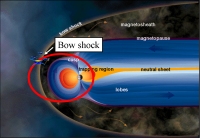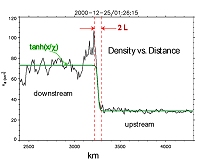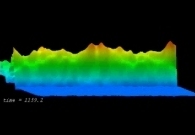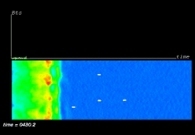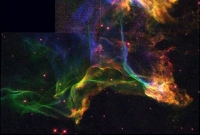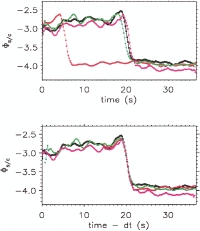Cluster reveals the natural scale of the Earth's bow shock thickness
The thickness of the Earth's bow shock is proportional to the gyroradius of ions, according to a large set of observations from the Cluster satellites. This dataset covers a broad distribution of thickness from a few km to 400 km.
|
Cluster orbit over a sketch of the Earth's magnetosphere (Copyright: ESA) |
Density transition from downstream to upstream. The green line is the hyperbolic tangent fit; red vertical lines show the density transition scale [Bale et al., 2003]. |
The thickness and the structure of the Earth's bow shock were studied before, in particular by using magnetic field data. This time, the first study of the density transition scale (top right graph) at 98 quasi-perpendicular shocks shows that the thickness of the shock is proportional to the downstream ion gyroradius. This result is in contrast with previous work based on magnetic field data.
This new discovery is expected to improve the modelling of collisionless shocks (see the above two animations). "Astrophysical and heliospheric shocks are abundant sources of energetic particles and the proposed mechanisms, which are not fully understood, seem to depend on the spatial scales of the shock", explained Dr. Stuart Bale, Co-Investigator of the Electric Field and Wave (EFW) experiment and lead author on this research, published 31 December 2003 in Physical Review Letters.
This result would not have been found without using the unique multipoint measurements capability of Cluster. As explained in the December 31 paper, for each bow shock crossing, measurements of a spacecraft floating potential, on the four Cluster spacecraft, have been used as a proxy for electron plasma density. A timing analysis gives shock speed and normal (see above image); the shock speed is used to convert the temporal measurement to a spatial one. On previous missions, the density transition scale has been rarely if ever investigated primarily because particle counting instruments traditionally have required one spacecraft spin to acquire a complete distribution function measurement and spacecraft spin rates are on the order of seconds.
Bale, S. D., Mozer, F. S., and Horbury, T. S., Phys. Rev. Lett. 91, 265004 (2003)
Contact
Stuart Bale, SSL, University of California, Berkeley, USA
Tel +1-510-643-3324
3D animations
Bertrand Lembege and Pierre Martel, CETP/CNRS/UVSQ/IPSL, Vélizy, France
Tel.+33-1-3925-4770
Web story author
Arnaud Masson, SCI-SH division, RSSD, ESA, The Netherlands
Tel: +31-71-565-5634
Web story editor
Philippe Escoubet, SCI-SH division RSSD, ESA, The Netherlands
Tel: +31-71-565-4564

